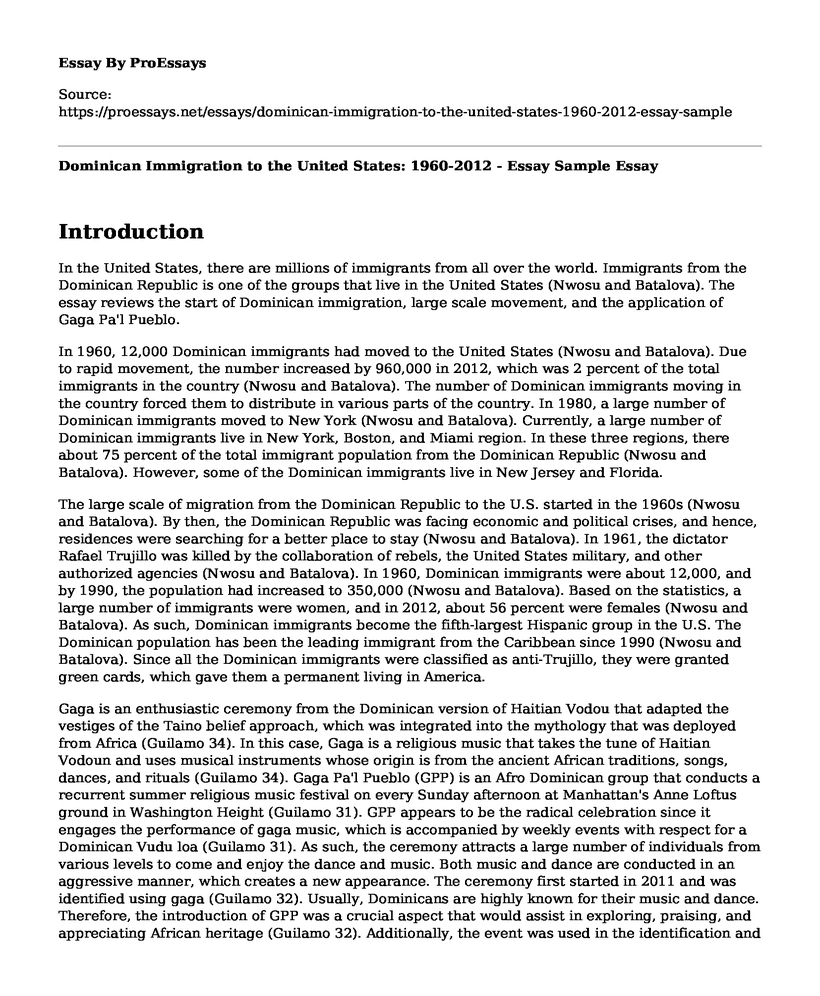Introduction
In the United States, there are millions of immigrants from all over the world. Immigrants from the Dominican Republic is one of the groups that live in the United States (Nwosu and Batalova). The essay reviews the start of Dominican immigration, large scale movement, and the application of Gaga Pa'l Pueblo.
In 1960, 12,000 Dominican immigrants had moved to the United States (Nwosu and Batalova). Due to rapid movement, the number increased by 960,000 in 2012, which was 2 percent of the total immigrants in the country (Nwosu and Batalova). The number of Dominican immigrants moving in the country forced them to distribute in various parts of the country. In 1980, a large number of Dominican immigrants moved to New York (Nwosu and Batalova). Currently, a large number of Dominican immigrants live in New York, Boston, and Miami region. In these three regions, there about 75 percent of the total immigrant population from the Dominican Republic (Nwosu and Batalova). However, some of the Dominican immigrants live in New Jersey and Florida.
The large scale of migration from the Dominican Republic to the U.S. started in the 1960s (Nwosu and Batalova). By then, the Dominican Republic was facing economic and political crises, and hence, residences were searching for a better place to stay (Nwosu and Batalova). In 1961, the dictator Rafael Trujillo was killed by the collaboration of rebels, the United States military, and other authorized agencies (Nwosu and Batalova). In 1960, Dominican immigrants were about 12,000, and by 1990, the population had increased to 350,000 (Nwosu and Batalova). Based on the statistics, a large number of immigrants were women, and in 2012, about 56 percent were females (Nwosu and Batalova). As such, Dominican immigrants become the fifth-largest Hispanic group in the U.S. The Dominican population has been the leading immigrant from the Caribbean since 1990 (Nwosu and Batalova). Since all the Dominican immigrants were classified as anti-Trujillo, they were granted green cards, which gave them a permanent living in America.
Gaga is an enthusiastic ceremony from the Dominican version of Haitian Vodou that adapted the vestiges of the Taino belief approach, which was integrated into the mythology that was deployed from Africa (Guilamo 34). In this case, Gaga is a religious music that takes the tune of Haitian Vodoun and uses musical instruments whose origin is from the ancient African traditions, songs, dances, and rituals (Guilamo 34). Gaga Pa'l Pueblo (GPP) is an Afro Dominican group that conducts a recurrent summer religious music festival on every Sunday afternoon at Manhattan's Anne Loftus ground in Washington Height (Guilamo 31). GPP appears to be the radical celebration since it engages the performance of gaga music, which is accompanied by weekly events with respect for a Dominican Vudu loa (Guilamo 31). As such, the ceremony attracts a large number of individuals from various levels to come and enjoy the dance and music. Both music and dance are conducted in an aggressive manner, which creates a new appearance. The ceremony first started in 2011 and was identified using gaga (Guilamo 32). Usually, Dominicans are highly known for their music and dance. Therefore, the introduction of GPP was a crucial aspect that would assist in exploring, praising, and appreciating African heritage (Guilamo 32). Additionally, the event was used in the identification and preservation of African artists. As such, the event was crucial in illustrating religious rituals that assisted in the celebration of AfroDominican life.
Conclusion
In conclusion, Dominican immigrants started moving to the United States in 1960. In 2012, there were 960,000 Dominicans in America. The establishment of Gaga Pa'l Pueblo was a crucial event that Dominican immigrants used to celebrate and appreciate African heritage.
Works Cited
Guilamo, Daly. "Gaga Pa'l Pueblo: A Critical Afro Dominican Celebration in New York City." Journal of Pan African Studies 9.10 (2016): 31-45.
Nwosu, Chiamaka, and Jeanne Batalova. "Immigrants from the dominican Republic in the United States." Migration Information Source (2014).
Cite this page
Dominican Immigration to the United States: 1960-2012 - Essay Sample. (2023, May 24). Retrieved from https://proessays.net/essays/dominican-immigration-to-the-united-states-1960-2012-essay-sample
If you are the original author of this essay and no longer wish to have it published on the ProEssays website, please click below to request its removal:
- Critical Evaluation of Bullying in Reference to Family Theories Essay
- Women Suffrage Movement 1865-1920 Essay Example
- White Rabbit Radio Hate Group Paper Example
- Volunteer Learning Project: Homelessness Life Experience
- Research Paper on Intimate Partner Violence: A Growing Public Health Concern
- Family Violence: Unacceptable Conduct Between Intimate Relationships - Essay Sample
- Four Waves of Terrorism: Understanding Coercive Violence Dynamics - Paper Example







